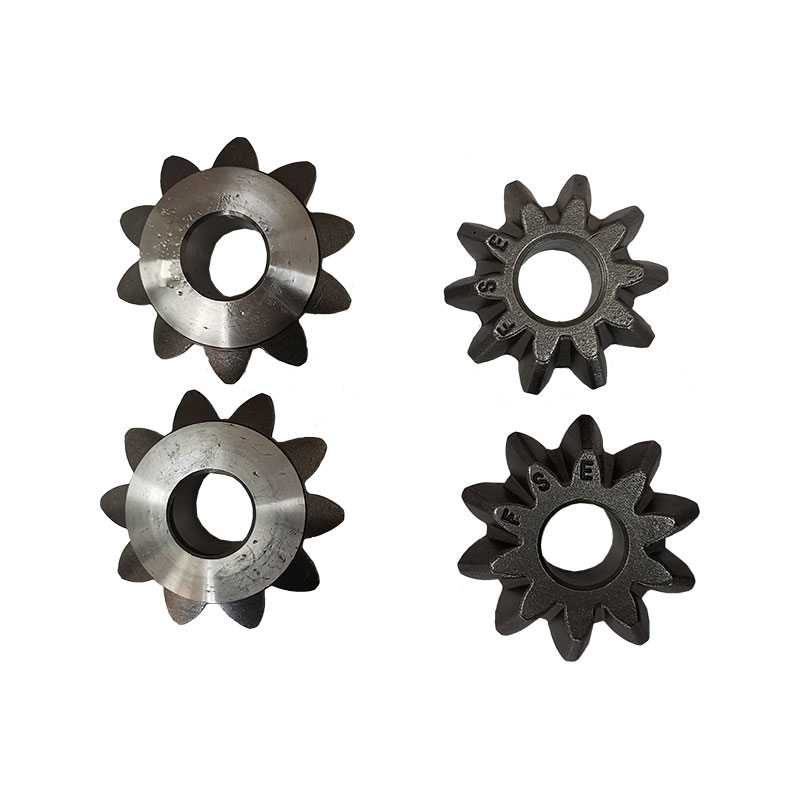Number of teeth z The total number of teeth of a gear. […]
Number of teeth z
The total number of teeth of a gear. Rack is a special gear with teeth distributed on the bar. Racks are also divided into straight racks and helical racks, which are paired with straight and spur gears, respectively; the tooth profile of the rack is straight rather than involute (planar for the tooth surface) , Equivalent to a cylindrical gear with an infinite circle radius.
Modulus m
The product of the tooth pitch and the number of teeth is equal to the circumference of the dividing circle, that is, pz=πd, where z is a natural number and π is an irrational number. The condition for making d a rational number is that p/π is a rational number, which is called a modulus. That is: m=p/π
Indexing circle diameter d
The gear tooth size of the gear is determined based on this circle, d=mz
Addendum circle diameter da and root circle diameter df
From the calculation formulas of the tooth top height and tooth root height, the calculation formulas of the tooth tip circle diameter and tooth root circle diameter can be derived: da=d+2ha df=d-2hf=mz+2m=mz-2×1.25m=m(z +2)=m(z-2.5)
The dividing circle of the gear is the basis for designing and calculating the dimensions of each part of the gear, and the circumference of the dividing circle of the gear =πd=zp, so the diameter of the dividing circle d=zp/π, because in the above formula π is an irrational number It is not convenient to position the reference circle as a reference. In order to facilitate calculation, manufacturing and inspection, the ratio p/π is artificially specified as some simple values, and this ratio is called the modulus, expressed in m, that is, its unit is mm. It follows that the modulus m is a basic parameter that determines the gear size. If the gear module with the same number of teeth is large, the size is also large. In order to facilitate manufacturing, inspection and interchangeability, the modulus values of gears have been standardized.

Indexing circle diameter d:
In the gear calculation, a circle must be specified as the reference circle for the size calculation, and the definition: the diameter is the circle of the product of the modulus times the number of teeth. It doesn't actually exist in the gear, just a defined circle. The diameter and radius are denoted by d and r, respectively, and the value is only related to the product of the modulus and the number of teeth. The modulus is the end modulus. It has nothing to do with the displacement coefficient. In the standard gear, the circle with the same groove width and tooth thickness (without considering the backlash) is the index circle. The standard gear drive coincides with the pitch circle. But in the case of index gears, the tooth groove and tooth thickness on the indexing circle will no longer be equal. In the case of a modified gear transmission, the index circle of the high displacement gear transmission still coincides with the pitch circle. However, the gear transmission with angular displacement separates the index circle and pitch circle.
Pressure angle α——At the tangent point P of the two gear pitch circles, the common normal of the two tooth profile curves (that is, the force direction of the tooth profile) and the common tangent of the two pitch circles (that is, the instantaneous motion direction at point P) The acute angle of the clip is called the pressure angle, also known as the engagement angle. Rack is a special gear with teeth distributed on the bar. Racks are also divided into straight racks and helical racks, which are paired with straight and spur gears, respectively; the tooth profile of the rack is straight rather than involute (planar for the tooth surface) , Equivalent to a cylindrical gear with an infinite circle radius. To a single gear is the tooth angle. The pressure angle of a standard gear is generally 20”.
The load capacity of the small pressure angle gear is small; while the high pressure angle gear, although the load capacity is high, the load of the bearing increases under the same transmission torque, so it is only used in special cases.
The modulus and number of teeth are the main parameters of the gear*. Rack is a special gear with teeth distributed on the bar. Racks are also divided into straight racks and helical racks, which are paired with straight and spur gears, respectively; the tooth profile of the rack is a straight line rather than an involute (flat surface for the tooth surface) , Equivalent to a cylindrical gear with an infinite circle radius.
In the case of the same number of teeth, the larger the modulus, the larger the gear teeth and the stronger the resistance to breaking. Of course, the larger the gear wheel blank, the larger the space size.
When the modulus is constant, the larger the number of teeth, the smoother the involute, and the thicker the top tooth thickness and the root tooth thickness are.